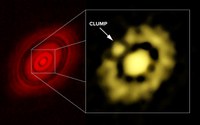The VLA View of the HL Tau Disk
 The first long-baseline ALMA campaign resolved the disk around the young star HL Tau into axisymmetric bright and dark rings. Despite the young age of HL Tau, these structures have been interpreted as signatures for the presence of proto-planets. Of special interest are the inner parts of disks, where terrestrial planets are expected to form. However, the emission from these regions in HL Tau are optically thick at ALMA wavelengths, preventing the derivation of surface density profiles and grain size distributions. Carrasco-Gonzalez et al. present the most sensitive images of HL Tau obtained to date with the Karl G. Jansky Very Large Array at 7.0 mm wavelength with a spatial resolution comparable to ALMA. At this wavelength, the dust emission from HL Tau is optically thin, enabling a comprehensive study of the inner disk. The authors obtain a total disk dust mass of 0.001 - 0.003 M⊙. Their VLA data indicate fast grain growth, fragmentation, and formation of dense clumps in the inner, densest parts of the disk. This research suggests that the HL Tau disk may be in a very early stage of formation, with planets not already formed in the gaps but in the process of future formation in the bright rings.
The first long-baseline ALMA campaign resolved the disk around the young star HL Tau into axisymmetric bright and dark rings. Despite the young age of HL Tau, these structures have been interpreted as signatures for the presence of proto-planets. Of special interest are the inner parts of disks, where terrestrial planets are expected to form. However, the emission from these regions in HL Tau are optically thick at ALMA wavelengths, preventing the derivation of surface density profiles and grain size distributions. Carrasco-Gonzalez et al. present the most sensitive images of HL Tau obtained to date with the Karl G. Jansky Very Large Array at 7.0 mm wavelength with a spatial resolution comparable to ALMA. At this wavelength, the dust emission from HL Tau is optically thin, enabling a comprehensive study of the inner disk. The authors obtain a total disk dust mass of 0.001 - 0.003 M⊙. Their VLA data indicate fast grain growth, fragmentation, and formation of dense clumps in the inner, densest parts of the disk. This research suggests that the HL Tau disk may be in a very early stage of formation, with planets not already formed in the gaps but in the process of future formation in the bright rings.
Image: [Left] ALMA image of HL Tau. [Right] VLA image of HL Tau, showing clump of dust. Credit: Carrasco-Gonzalez, et al.; Bill Saxton, NRAO/AUI/NSF.
Science Team: Carlos Carrasco-Gonzalez (UNAM), Thomas Henning (MPIfA), Claire J. Chandler (NRAO), Hendrik Linz (MPIfA), Laura Perez (MPIfA, NRAO, MPIfR), Luis F. Rodriguez (UNAM), Roberto Galvan-Madrid (UNAM), Guillem Anglada (CSIC), Til Birnstiel (MPIfA), Roy van Boekel (MPIfA), Mario Flock (JPL), Hubert Klahr (MPIfA), Enrique Macias (CSIC), Karl Menten (MPIfA), Mayra Osorio (CSIC), Leonardo Testi (ESO, INAF), Jose M. Torrelles (CSIC-IEEC), and Zhaohuan Zhu (Princeton).
Publication: The VLA view of the HL Tau Disk: Disk Mass, Grain Evolution, and Early Planet Formation, 2016, Astrophysical Journal Letters, 821, L16.




Connect with NRAO